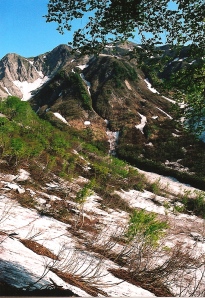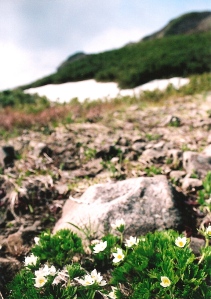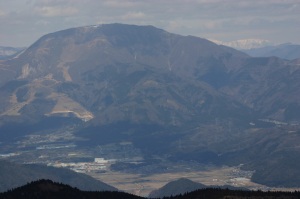Exactly 2 weeks to the day after my thrilling climb of Mt. Amakazari, I sit in a tent at the beginning of a gated forest road, plotting my next move. Fumito and I are about to embark on another gargantuan hike of a mighty mountain, during the rainy season! Could I continue my lucky streak in the battle against the rain?

4:00am. With the skies still dark and the wind calm, breakfast is cooked and served. We’ve got a long way to go on one of the toughest day hikes in the Kita Alps, so an early start was critical. After breaking down camp, I took a short stroll across the river to try to catch a glimpse of the ridge line, in hopes of assessing snow conditions. Crampons were foregone in favor of ice axes. The weight we’d save would be replaced by nutrients. The red glow of the sun on the high peaks was promising, as was the lack of cloud cover. Barometer readings were also in our favor, so we set out on the long, deserted forest road in high spirits.

At the end of the road, we headed into the hills, along the Akaiwa spur for a 1200m+ altitude gain. Step by step we rose high above the valley, shedding layers of clothing with each advancing trot. It was hot, and oh so clear. “What happened to the rainy season?”, I asked Fumito, hoping that my question wouldn’t set mother nature off on a temper tantrum.

About 90 minutes into our climb, nature threw up its first road block: a huge ice fall blocking the path in front of us. Beyond that, there was a steep snow field that was impassable without crampons. By sheer luck, someone had hacked out a ridiculously steep alternative route, bypassing our obstacle. Grabbing whatever lay in our path, we forced our way up and around the barrier. Fumito took the lead, while I followed a short distance behind. All of a sudden, my companion lost his balance and grip, sliding above me to my left. Acting on my reflexes, I reached out and grabbed his backpack, but the bag slipped right through my hand, cutting two fingers in the process.
Just as my worst nightmare was beginning to see the light of day, I witnessed the most impressive feat of my entire existence on this earth. Tumbling barely 5 meters, Fumito somehow managed to break his fall in the canopy of a small beech tree, thus averting a major disaster. The entire event unfolded in the blink of an eye, as the luckiest man in Japan climbed back up while I tended to my wounds. “I’ll take the lead from here,” I quipped.

Once out of the danger zone, we found the normal path and took a break to reflect on what transpired. Fumito was completely unharmed, and I’d lost some skin on my fingers, but the bleeding had stopped so we ventured on. We arrived at Takachihodai, where our first glimpse of Kashimayari came into view directly in front of us. If we could somehow build a rope bridge over the huge valley between us and the peak, then we could cut a few hours off the slog. Unfortunately, we’d have to continue climbing parallel to the peak until reaching the ridgeline, where we’d be able to head over to the summit.

The path became much rockier after leaving the flat area, but fortunately most of the snow was gone. Just before popping out on the ridge though, we had to traverse through a large, unstable snow field. I was petrified of breaking through the snow and tumbling down to my death, so Fumito once again took the lead. This time, he kept his footing and I managed to avoid the holes, but we wondered how we’d be able to traverse it on the descent.

We hit the main ridge line, where Tateyama and Tsurugi were patiently waiting. Mt. Fuji even popped her head out on the horizon and the sky looked as if satsuki-bare had never left. We marched on to the mountain hut and filled up on water. Then came a gargantuan climb through an enormous snowfield to the summit of Mt. Nunobiki. Exhausted we were, but we plodded on, reaching the top of the southern peak just before noon. Mt. Kashimayari, just like Mt. Shiomi in the Minami Alps, has a twin peak a short distance away. After eating lunch, we dropped to the saddle and climbed the twin, staring down into the vertical crags on the Hachimine-kiretto. There’d be no traversing over to Mt. Goryu this time around, even though it was still on my ‘to climb’ list.

We ran into a handful of people on the summit, but all of them had come from Ogisawa – a much longer but easier approach. After celebrating our successful ascent, we retraced out steps back to the junction, thinking about the tricky snow traverse that lie ahead. This time around I took the lead, and was extremely surprised to find that some kind soul had built steps into the snow pack, making for an easy and comfortable crossing. My guess is that the hut staff must’ve come over here with their snow shovels, or perhaps another hiker had come up behind us. Whoever it was, I can’t thank them enough.

Descending took no time at all, and the high pressure system stuck around for the duration of our hike. Walking back on the deserted forest road, Fumito and I chatted about our previous adventures and wondered if we’d be able to get together again this year for more hikes. I hung up the hat after this one, deciding not to tempt fate again until after the rainy season, where mountain #83 was quietly awaiting.




































